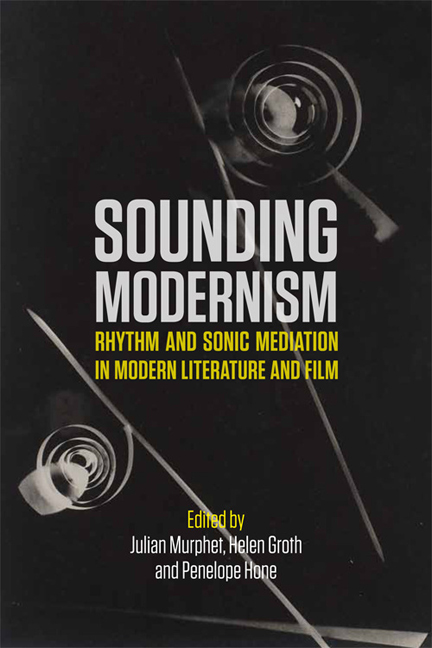Book contents
- Frontmatter
- Contents
- Acknowledgements
- 1 Introduction: Sounding Modernism 1890–1950
- Part One Writing Modern Sound
- Part Two Mediated Voices
- Part Three Difficult Voices
- Part Four Modern Rhythm: Writing, Sound, Cinema
- 12 The Rhythms of Character in Katherine Mansfield's ‘Miss Brill’
- 13 The Rhythm of the Rails: Sound and Locomotion
- 14 Two-step, Nerve-tap, Tanglefoot: Tapdance Typologies in Cinema
- Notes on Contributors
- Bibliography
- Index
12 - The Rhythms of Character in Katherine Mansfield's ‘Miss Brill’
from Part Four - Modern Rhythm: Writing, Sound, Cinema
Published online by Cambridge University Press: 22 December 2017
- Frontmatter
- Contents
- Acknowledgements
- 1 Introduction: Sounding Modernism 1890–1950
- Part One Writing Modern Sound
- Part Two Mediated Voices
- Part Three Difficult Voices
- Part Four Modern Rhythm: Writing, Sound, Cinema
- 12 The Rhythms of Character in Katherine Mansfield's ‘Miss Brill’
- 13 The Rhythm of the Rails: Sound and Locomotion
- 14 Two-step, Nerve-tap, Tanglefoot: Tapdance Typologies in Cinema
- Notes on Contributors
- Bibliography
- Index
Summary
In the early decades of the twentieth century, many writers and critics saw rhythm as being able to mediate between world and text. A number of modernists were also thinking about subjectivity in terms of rhythm, with some even considering rhythm to be the very essence of being. Prose was often considered the best medium for expressing these rhythms of subjectivity in literature, and Katherine Mansfield's short fiction is a significant example of this tendency. Her perception of the rhythmic qualities in speech, thought, emotion and indeed being pervades her oeuvre, and is particularly evident in those stories that are primarily studies of character. In her 1920 short story, ‘Miss Brill’, the title character is mediated through rhythms.
As this essay will demonstrate, while Mansfield does evoke the sonic rhythms of Miss Brill's voice and thought, her ultimate aims in this are to limn the complexity of a character's emotional state and even being through rhythmic mediation. The resolute cheerfulness of Miss Brill's voice, which reaches us through free indirect discourse, is repeatedly undercut by a discordant undertone of melancholy. This bifurcation of the protagonist's voice can be productively understood, making use of terminology from Henri Lefebvre's Rhythmanalysis (1992), as ‘arrhythmic’. Lefebvre explains arrhythmia as a situation in which rhythms are ‘discordant’, causing ‘suffering, a pathological state (of which arrhythmia is generally, at the same time, symptom, cause and effect)’ (16). This concept helps us to recognise the two currents of cognition apparent in Miss Brill's voice as discordant and perhaps even bordering on the pathological. This contributes to a pattern of habitual self-deception that recurs at multiple levels of the story. The influence of the relatively new field of psychology is apparent in the story's exploration of consciousness, personality, emotion and the relation between self and world. In addition, Mansfield's use of rhythms to mediate character serves a political purpose. It enables a deeper portrayal of the loneliness experienced by her marginalised subject (a single, childless, older woman), and the exposure of the social structures that lead to it.
- Type
- Chapter
- Information
- Sounding ModernismRhythm and Sonic Mediation in Modern Literature and Film, pp. 181 - 192Publisher: Edinburgh University PressPrint publication year: 2017

